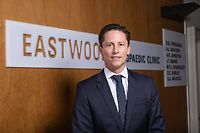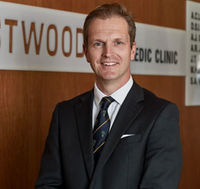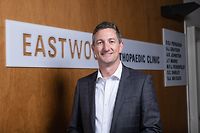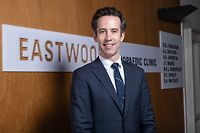Central Auckland, East Auckland, North Auckland, South Auckland, West Auckland > Private Hospitals & Specialists >
Eastwood Orthopaedic Clinic
Private Service, Orthopaedics
Today
8:00 AM to 4:30 PM.
Description
- Arthroscopic Knee Surgery
- ACL Reconstruction
- Foot & Ankle Surgery
- General Orthopaedic Surgery
- Hip & Knee Joint Replacement
- Hip Resurfacing
- Orthopaedic Oncology
- Paediatrics
- Shoulder Surgery
- Spine Surgery ( Adult & Paediatric)
- Tumour Surgery
- Our consultants are:
- Duncan Ferguson - Knee & Shoulder Surgery
- Andrew Graydon - Paediatric Orthopaedic & Tumour Surgery
- Andrew Johnston- Hip & Knee Surgery, Orthopaedic Oncology & General Orthopaedics
- Jacob Munro - Hip & Knee Surgery, Hip Resurfacing
- Otis Shirley - Spine Surgery ( Adult & Paediatric )
- Stephanie van Dijck - Paediatric and General Orthopaedic Surgeon
- Mark Wright -Shoulder, Hip & Knee Surgery
What is Orthopaedics?
Consultants
-

Mr Duncan Ferguson
Orthopaedic Surgeon - Knee and Shoulder Specialist
-

Mr Andrew Graydon
Paediatric Orthopaedic, Tumour Surgeon
-

Mr Andrew Johnston
Hip & Knee Surgery. Orthopaedic Oncology
-

Mr Jacob Munro
Hip and Knee Orthopaedic Surgeon
-

Mr Otis Shirley
Orthopaedic Surgeon, Spine Surgery (Adult & Paediatric)
-

Stephanie Van Dijck
Paediatric and General Orthopaedic Surgeon
-
Mr Mark Wright
Shoulder, Hip and Knee Orthopaedic Surgeon
Referral Expectations
We will require a letter from a GP, physiotherapist or another specialist explaining your condition for all new appointments.
We will also require:
4. Your Medical Insurer if required.
Hours
8:00 AM to 4:30 PM.
| Mon – Fri | 8:00 AM – 4:30 PM |
|---|
Phone (09) 522 0103
Procedures / Treatments
For elderly patients joint replacement surgery is commonly required to treat damaged joints from wearing out, arthritis or other forms of joint disease including rheumatoid arthritis. In these procedures the damaged joint surface is removed and replaced with artificial surfaces normally made from metal (chromium cobalt alloy, titanium), plastic (high density polyethelene) or ceramic which act as alternate bearing surfaces for the damaged joint. These operations are major procedures which require the patient to be in hospital for several days and followed by a significant period of rehabilitation. The hospital has several ways of approaching the procedure for replacement and the specifics for the procedure will be covered at the time of assessment and booking of surgery. Occasionally blood transfusions are required; if you have some concerns raise this with your surgeon during consultation.
For elderly patients joint replacement surgery is commonly required to treat damaged joints from wearing out, arthritis or other forms of joint disease including rheumatoid arthritis. In these procedures the damaged joint surface is removed and replaced with artificial surfaces normally made from metal (chromium cobalt alloy, titanium), plastic (high density polyethelene) or ceramic which act as alternate bearing surfaces for the damaged joint. These operations are major procedures which require the patient to be in hospital for several days and followed by a significant period of rehabilitation. The hospital has several ways of approaching the procedure for replacement and the specifics for the procedure will be covered at the time of assessment and booking of surgery. Occasionally blood transfusions are required; if you have some concerns raise this with your surgeon during consultation.
The division of a crooked or bent bone to improve alignment of the limb. These procedures normally involve some form of internal fixation, such as rods or plates, or external fixation which involves external wires and pins to hold the bone. The type of procedure for fixation will be explained when the surgery is planned.
The division of a crooked or bent bone to improve alignment of the limb. These procedures normally involve some form of internal fixation, such as rods or plates, or external fixation which involves external wires and pins to hold the bone. The type of procedure for fixation will be explained when the surgery is planned.
Over the last 30 years a large number of orthopaedic procedures on joints have been performed using an arthroscope, where a fiber optic telescope is used to look inside the joint. Through this type of keyhole surgery, fine instruments can be introduced through small incisions (portals) to allow surgery to be performed without the need for large cuts. This allows many procedures to be performed as a day stay and allows quicker return to normal function of the joint. Arthroscopic surgery is less painful than open surgery and decreases the risk of healing problems. Arthroscopy allows access to parts of the joints which can not be accessed by other types of surgery.
Over the last 30 years a large number of orthopaedic procedures on joints have been performed using an arthroscope, where a fiber optic telescope is used to look inside the joint. Through this type of keyhole surgery, fine instruments can be introduced through small incisions (portals) to allow surgery to be performed without the need for large cuts. This allows many procedures to be performed as a day stay and allows quicker return to normal function of the joint. Arthroscopic surgery is less painful than open surgery and decreases the risk of healing problems. Arthroscopy allows access to parts of the joints which can not be accessed by other types of surgery.
In many cases tendons will be lengthened to improve the muscle balance around a joint or tendons will be transferred to give overall better joint function. This occurs in children with neuromuscular conditions but also applies to a number of other conditions. Most of these procedures involve some sort of splintage after the surgery followed by a period of rehabilitation, normally supervised by a physiotherapist.
In many cases tendons will be lengthened to improve the muscle balance around a joint or tendons will be transferred to give overall better joint function. This occurs in children with neuromuscular conditions but also applies to a number of other conditions. Most of these procedures involve some sort of splintage after the surgery followed by a period of rehabilitation, normally supervised by a physiotherapist.
Public Transport
The Auckland Transport Journey Planner will help you to plan your journey.
Parking
Patient parking is provided under our building. Please enter our driveway on the left hand side of the building.
Website
Contact Details
4 St Marks Road, Remuera, Auckland
Central Auckland
8:00 AM to 4:30 PM.
-
Phone
(09) 522 0103
Healthlink EDI
eastwood
Website
4 St Marks Road
Remuera
Auckland
Street Address
4 St Marks Road
Remuera
Auckland
Postal Address
4 St Marks Road
Remuera
Auckland 1050
Was this page helpful?
This page was last updated at 11:19AM on September 23, 2024. This information is reviewed and edited by Eastwood Orthopaedic Clinic.

